The Skillful Craftsmen in Lingnan · The Guardians of Ancient Buildings | Endurable and Unfading Charm from Stone Seeds Brushed with Pure Water
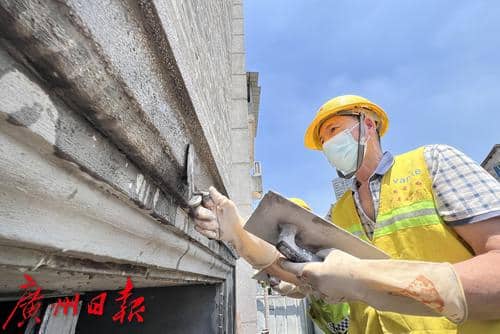
在广州大街小巷,在深圳南头古城,在开平碉楼群落,处处可见一种石米墙。表面平嵌上一层碾碎的小石子,将一栋建筑细致入微地包裹起来,如同坚硬的外壳,为它遮风挡雨,为它妆点面容。
The stone seed wall can be seen everywhere on the streets of Guangzhou, in the Nantou Ancient Town of Shenzhen and in the Kaiping Watchtower Complex. A layer of crushed stones embedded in the walls wraps up a building, leaving no corner untouched. It works as a hard and decorative shell that prevents the building away from wind and rain.
这种工艺叫水刷石,起源于归国华侨对西式技法的兼容并蓄,得名于制作过程中不断刷洗石米的动作。水刷之后,古朴的颜色经久不褪,味道既如一壶酒越陈越香,又如漂洗后的岁月宁静致远,极符合岭南人低调实用的审美趣味,从而造就了一个美的时代符号。
This craft is named granitic plaster after the action of constantly scrubbing stone seeds during the construction process, and originated from the incorporation of western techniques by overseas returnees. After the water brush process, the primitive color will endure for long. Its lasting charm exists like a pot of liquor that grows mellower with the time, and a period of weather-beaten years in which one secures his final win through the cool, calm and consistent diligence. This building technique accords particularly with Cantonese low-profile and pragmatic aesthetic taste, thus creating a beautiful symbol of the times.
如今,水刷石匠人依然在民间活跃,成为这批近现代岭南建筑的守护人,并娓娓道来水刷石工艺从发轫至盛行的历史过程。
Nowadays, granitic plaster craftsmen are still active in the society and become the guardians of this batch of modern Lingnan buildings. They are about to vividly depict the historical course of granitic plaster process from its humble germination to its thriving prevalence.
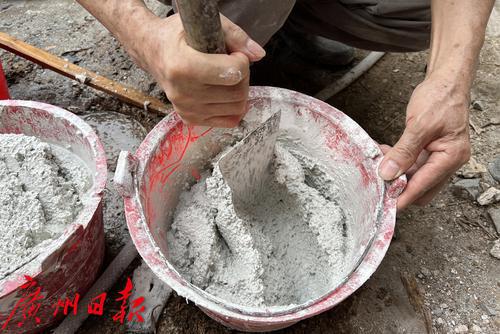
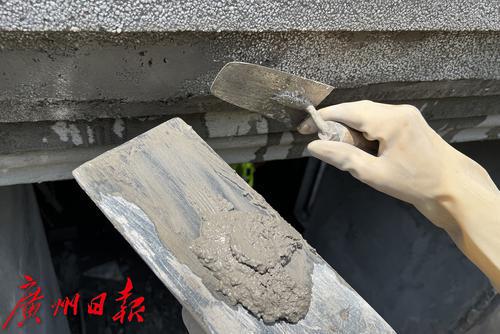
56岁的吴伟职在水刷石行业干了40年,今年5月,他在荔湾区南漖村的武帝古庙进行古建修复。武帝古庙始建于清代中叶,距上次重修有70多年,亟须解决各类外墙开裂的问题。只见他细细检查庙中的石柱,在坑洼之处补刷石米,使之恢复水刷石应有的模样。
The 56-year-old Wu Weizhi has dedicated to granitic plaster for 40 years. He was restoring the ancient Wudi Temple at Nanjiao Village in Liwan District in this May. The ancient Wudi Temple was originally constructed in the middle of the Qing Dynasty. It has been more than 70 years since its last restoration. Therefore, the Temple was in urgent need to solve the problem of various external wall cracks. Mr. Wu examined the stone columns in the temple attentively, and filled stone seeds in all depressions to restore their proper appearances as granitic plaster.
水刷石的工艺相当繁复,俗称“洗三磨三”,即要洗刷三次、打磨三次。吴伟职现场演示了一遍,他先将水泥和石米混合加水搅拌,直接抹上墙面,后者已薄薄地刷了一层水泥,再让石米更加牢固地黏上去。等候其半凝固时,墙面只看得到水泥的黑。
The granitic plaster craft is pretty complicated and commonly known as “three times of washing and grounding”. That is, the granitic plaster should be washed and grounded for three times. To make it clearly, Mr. Wu demonstrated this process on the spot. Firstly, he plastered a thin layer of cement slurry on the wall surface. Then, he applied the cement and stone seed mortar, which had been mixed with water in advance, directly on the wall, so that stone seeds could stick on the surface firmly. When the mortar was semi-solidified, the dark ink of cement was noticeable on the wall.
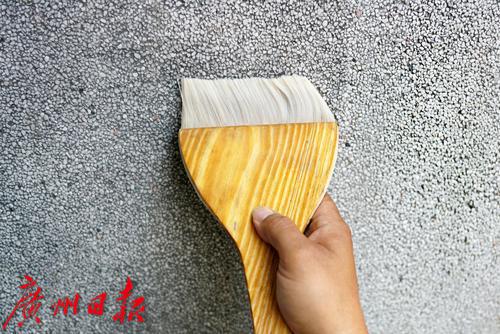
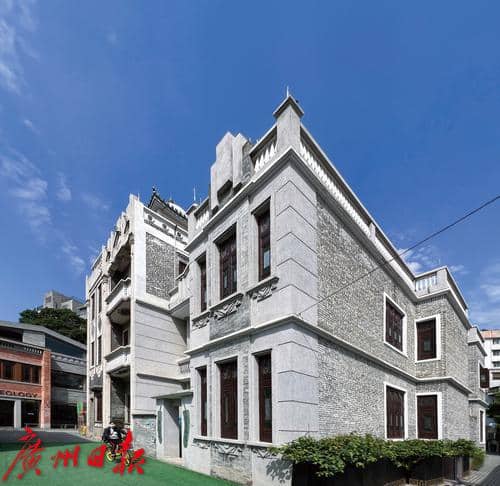
一个熟练的匠人,一天只能做0.3平方米的水刷石。在永庆坊的吉祥坊3号民居,光是一条柱子,就花了两位匠人10天的水磨功夫,价格比直接贴砖贵上3倍。在水刷石刚开始流行时,只有大户人家才能用得上这种造价昂贵的工艺。
A skillful craftsman can only complete 0.3 m2 of granitic plaster per day. It took two craftsmen 10 days to finish the water grinding for just one pillar at No. 3 residential building of Jixiang Fang in Yongqing Fang. The cost is three times more expensive than direct tiling. When granitic plaster just became popular, only those wealthy and influential families could afford such an expensive craft.
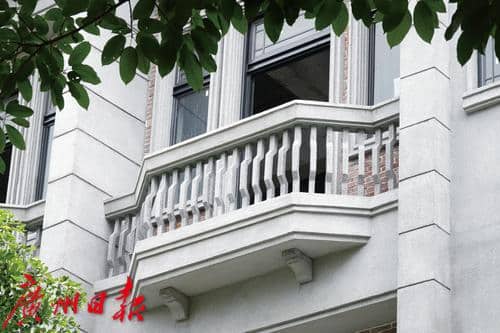
“现在做这一行的人越来越少,大部分都是五六十岁上了年纪的老师傅,过去十来年几乎都没有再做这个工艺。近几年大量古建筑开始修缮,我们这批人又走出来,继续坚守这个行业,”水刷石匠人吴汝玩说,他很珍惜现在的时光,希望能用精湛的技艺延续好古建筑的生命。
“Craftsmen engaging in this profession are constantly declining and most of us are above 50 years old. There were few projects during the last decade or so. It was only in recent years when a great deal of ancient buildings began to be renovated that we reappeared to continue sticking to this profession.” Wu Ruwanplay, a granitic plaster craftsman, said that he cherishes the present time and opportunities and hopes to continue the life of ancient buildings by virtue of his exquisite skills.
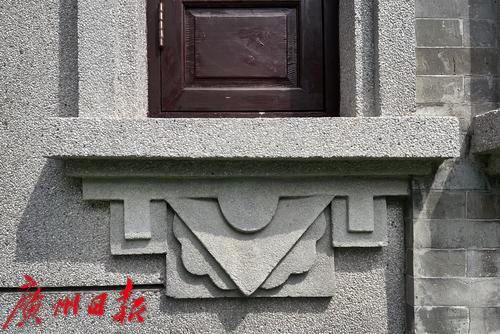
从事水刷石行业是个辛苦活,不仅工作时间长,而且方式相对单调。无论是吴汝玩还是吴伟职,都感叹越来越难找到年轻人干这行。不过在武帝古庙的修复现场,“95后”小伙子张炜湛成为难得一见的年轻面孔。张炜湛来自开平,家中也从事水刷石工作,从小耳濡目染,从拜师到工作至今,他已入行四年。
Granitic plaster is a tough job. It not only takes long work hours but also goes in a relatively monotonous way. Both Wu Ruwan and Wu Weizhi lament the increasing difficulty in finding young people to engage in this profession. However, Zhang Weizhan, a young man born after 1995, becomes a rarely seen young face on the restoration site of the Wudi Temple. Mr. Zhang is from Kaiping and brought up in a family that have been engaging in granitic plaster. He has been immersed in this profession since childhood and doing this job for 4 years since his apprenticeship.
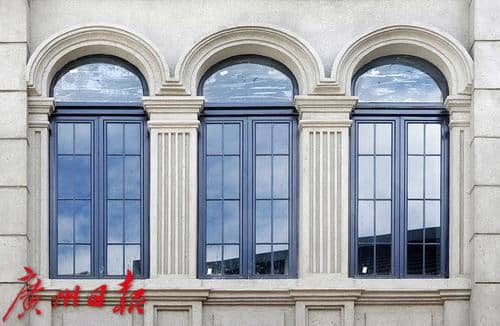
张炜湛开玩笑道,这行真是“赚钱又减肥”。因为干水刷石要全身出力,很多时候连坐的地方都没有,只能单膝跪地一直刷墙,做得久了腿都麻了,甚至都站不起来。过去张炜湛身子胖,蹲都蹲不下,两三年下来足足瘦了20斤。
“This is really a profitable and weight-losing job.” Mr. Zhang joked. That is because granitic plaster requires the forces from whole body. For most of the time, there was no place for him to sit. He had to get down on one knee to keep brushing the wall for so long that his legs went numb and that he could barely stand up. Previously, Mr. Zhang was so fat that he could hardly squat. However, within 2 to 3 years of hard work, he has surprisingly lost 10 kilograms.
“不怕苦”“不怕邋遢”,是张炜湛能坚持下来的重要原因。他说,水刷大幅墙面时,为了保证颜色质地的统一,要连排10个人同时用水龙头刷,场面更加“邋遢”,但看到古建筑焕发了“第二春”,一切付出都是值得的。
Assiduity and diligence are two reasons why Mr. Zhang can stick it out. According to him, when it comes to the granitic plaster on a large wall, 10 people in a row will be arranged simultaneously to brush the wall, so as to ensure the unity of color and texture, which is an even more “dirty” scene. However, it makes all worthwhile to personally see an ancient building being revitalized.
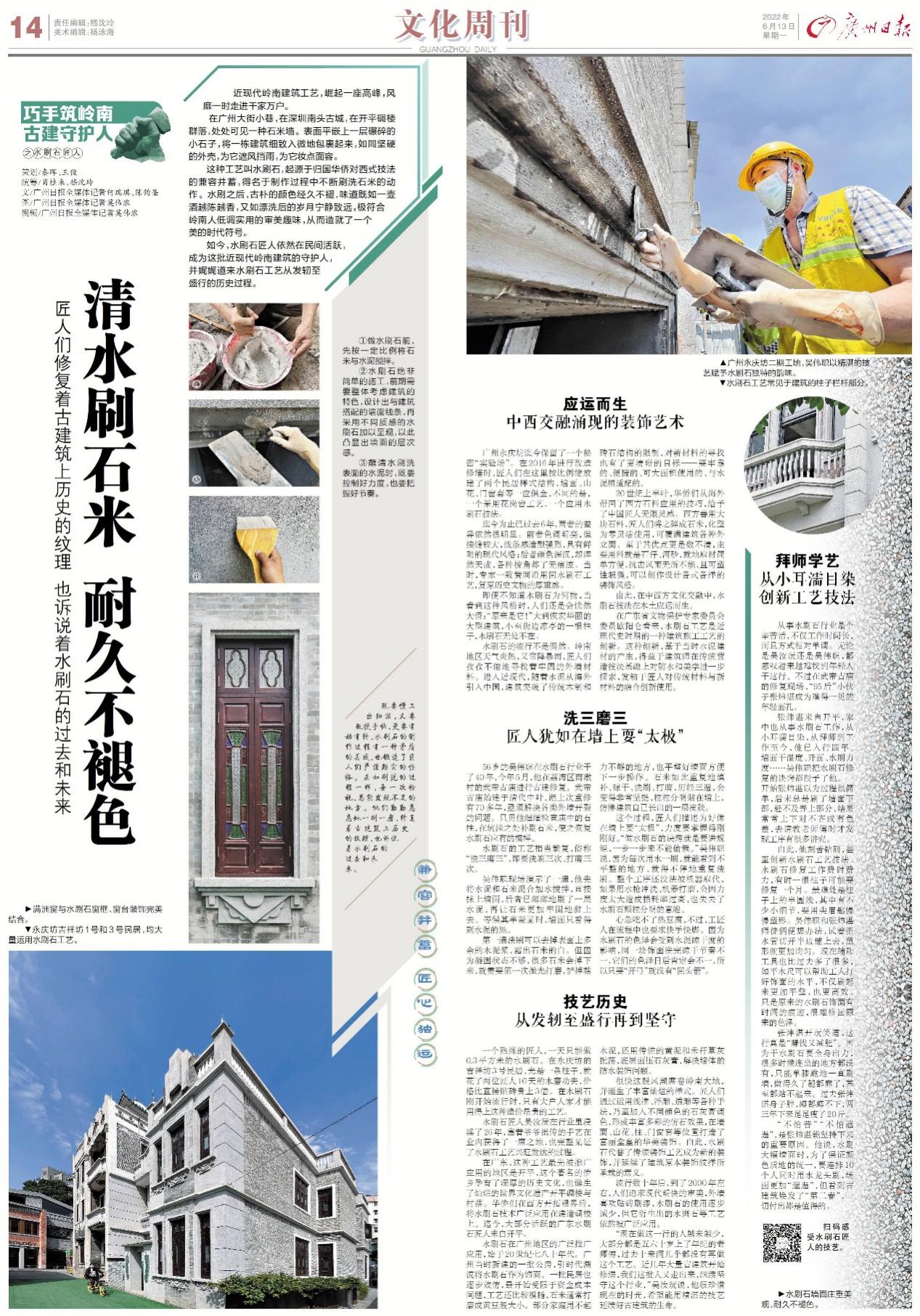
来源:广州日报
Source: Guangzhou Daily
统筹/秦晖 肖桂来
Report planning: Qin Hui and Xiao Guilai
作者:何瑞琪、陈钧圣、莫伟浓
Author:He Ruiqi ,Chen Junsheng and Mo Weinong











